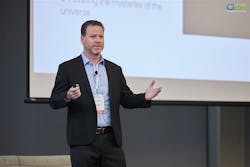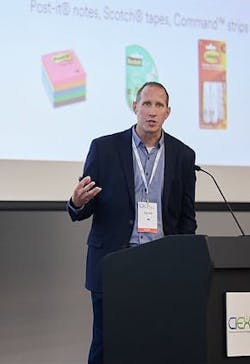CIEX Attendees Hear How Digital Tools Are Accelerating Innovation
Key Highlights
- Syensqo used AI to identify a new polymer in 18 months, a process that would traditionally take five to six years, demonstrating the power of digital technologies in accelerating R&D.
- Dow employs high-throughput robotics to produce over 10,000 samples weekly, significantly speeding up product development and enabling precise control over formulations for applications like battery safety.
- 3M is investing in lab automation and machine learning to enhance adhesive testing, addressing bottlenecks and increasing data collection speed and density.
Innovation leaders from the chemical industry gathered in Indianapolis last week to discuss the future of research and development in a fast-changing digital environment, sharing examples of dramatic breakthroughs enabled by artificial intelligence and robotics.
The two-day Chemical Innovation Exchange, or CIEX, conference took place at the headquarters and meeting center for The Heritage Group, owner of several companies focused on construction materials, specialty chemicals and environmental services.
Syensqo's AI-Powered Polymer Discovery
The convergence of sustainability and rapid innovation using AI and other digital technologies was an ongoing theme throughout the event. Ryan Murphy, technology manager at Syensqo, presented one of the more dramatic examples of AI transforming the R&D cycle.
Over 18 months, researchers from the company, spun off from Solvay in 2023, used AI to search a database of 4 million molecules before landing on a single polymer that met the company's requirements. It’s a feat that would have taken an estimated five to six years using traditional methods, Murphy said.
"When we took a look at the problem and our chemists put their heads together, they realized that there's a tremendous amount of opportunity to comb through from a structure perspective," Murphy said. "So how do we tackle this?"
The company used AI and data science to whittle down the millions of molecules to a few hundred promising candidates for a polymer that had specific properties, including UV stability and thermal resistance. The researchers then employed physics-based simulations to further refine their selections before bringing the most promising options into the lab for testing, Murphy told more than 100 people attending the event.
Dow's High-Throughput R&D Push
At Dow, the company is employing high-throughput research strategies, including the use of robotics, to supercharge the company’s R&D processing capabilities, said A.N. Sreeram, Dow’s chief technology officer. The high-throughput process allows the company to bring discoveries to market twice as fast, Sreeram said.
Sreeram cited an example of how Dow uses robotics to accelerate product development in consumer applications like surface cleaners and detergents. The robots dispense various chemical precursors to create initial formulations for primary screening tests. In secondary screening phases, the robots handle tasks like making polymer samples and precisely weighing materials before and after reactions.
The company's automated systems can produce over 10,000 samples per week—a scale impossible to achieve with traditional manual methods.
"You cannot hire unskilled labor in Timbuktu to be lower cost,” he said. It's not about the cost."
The automated process allows researchers to precisely control formulation variables and use digital line scans to quantify properties like foaming characteristics in soaps.
Sreeram also described Dow's work developing materials to prevent thermal runaway in lithium-ion batteries—a dangerous condition where one overheating battery cell can cause neighboring cells to catch fire, potentially destroying an entire battery pack.
The company uses high-throughput robotics to formulate silicone foam materials that can contain battery fires. Their testing involves deliberately triggering thermal runaway in one cell to see if their materials can prevent the fire from spreading to adjacent cells.
Sreeram cited additional examples of high-throughput R&D, including the use of quantum computing and digitized research reports to advance next-generation technologies. Dow has digitized all the company’s research reports dating back to its early years,
“Along with all the data and literature, we run a lot of deep learning and ML work,” Sreeram said.
3M Automates Adhesive Testing
3M has begun investing in lab automation to advance its efforts around new adhesives, said Guy Joly, the company’s vice president of R&D. The company’s digital R&D initiative is a multiyear journey with several challenges that 3M must address to move forward, including intellectual property and security concerns, Joly said.
The company is using a three-tiered approach that progresses from digitizing experiments to integrating multiple automated steps.
One major focus has been addressing bottlenecks in rheology testing—the study of how materials flow under stress. The company invested in high-throughput capabilities that allow researchers to load data into the cloud, run experiments overnight and find processed data ready for analysis the next morning.
3M researchers are using machine learning to collect rheology data two to four times faster than they could using traditional methods with about 10 times the data density, Joly said.
Many speakers emphasized that technology alone can’t advance innovation in the chemical industry.
3M has external partnerships with universities and government labs, Joly said. The company also has an internal division called 3M New Growth Ventures, a venture capital arm that invests in startups.
Industry Collaboration Key to Future Innovation
Competitive partnerships will be critical as the industry moves forward on new initiatives, said William Green, an MIT chemical engineering professor and director of the MIT Energy Initiative. Global wars, the pandemic and trade tensions have thrown many plans, often driven by government-led initiatives or regulations, into disarray.
He also called on chemical manufacturers to lead the way for future innovations by talking to each other.
“We can only make big changes if we move together in concert,” he said. “So it's very reasonable to feel paralyzed and just feel like, well, I'll just watch out for my company, I'll do what's good for us now, and we'll see what happens next. But of course, that's exactly the opposite of how you want to be thinking.”
About the Author
Jonathan Katz
Executive Editor
Jonathan Katz, executive editor, brings nearly two decades of experience as a B2B journalist to Chemical Processing magazine. He has expertise on a wide range of industrial topics. Jon previously served as the managing editor for IndustryWeek magazine and, most recently, as a freelance writer specializing in content marketing for the manufacturing sector.
His knowledge areas include industrial safety, environmental compliance/sustainability, lean manufacturing/continuous improvement, Industry 4.0/automation and many other topics of interest to the Chemical Processing audience.
When he’s not working, Jon enjoys fishing, hiking and music, including a small but growing vinyl collection.
Jon resides in the Cleveland, Ohio, area.



